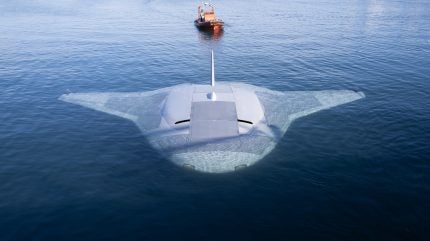
Northrop Grumman’s Manta Ray prototype UUV has passed in-water testing off the coast of Southern California, showcasing its modular design and potential for real-world deployment.
The testing phase showcased the vehicle’s hydrodynamic performance, encompassing submerged operations utilising its modes of propulsion and steering, including buoyancy, propellers, and control surfaces.

Discover B2B Marketing That Performs
Combine business intelligence and editorial excellence to reach engaged professionals across 36 leading media platforms.
Northrop’s expertise in advanced networking solutions and platform development has led to its participation in the US Navy’s Manta Ray and Angler UUV development programmes, as explained in GlobalData’s “Thematic Intelligence: Unmanned Maritime Vehicles 2023” report.
To embed unmanned vehicles into the future fleet structure, the US Navy has been making investments in several areas, including large and medium USVs, extra-large UUVs, large UUVs, Manta Rays, and more.
Dr Kyle Woerner, DARPA programme manager for Manta Ray, expressed enthusiasm for the testing, emphasising the vehicle’s readiness for practical deployment. “Our successful, full-scale Manta Ray testing validates the vehicle’s readiness to advance toward real-world operations after being rapidly assembled in the field from modular subsections,” said Dr Woerner.
The combination of cross-country modular transportation, in-field assembly, and subsequent deployment demonstrates a first-of-kind capability for an extra-large UUV.”

US Tariffs are shifting - will you react or anticipate?
Don’t let policy changes catch you off guard. Stay proactive with real-time data and expert analysis.
By GlobalDataThe US Defense Advanced Research Projects Agency (DARPA) awarded Phase 2 contracts for its Manta Ray project in 2021, selecting Northrop Grumman Corporation alongside Martin Defense Group and Metron.
A notable aspect of the Manta Ray prototype’s testing phase was the logistics demonstrated by Northrop Grumman, which shipped the vehicle in subsections from its build location in Maryland to the testing site in California. This approach showcases the ease of transportation and supports the possibility of rapid deployment on a global scale without monopolising pier space at naval facilities.
“Shipping the vehicle directly to its intended area of operation conserves energy that the vehicle would otherwise expend during transit,” continued Dr. Woerner.
With its design featuring multiple payload bays of various sizes and types, the Manta Ray prototype holds promise for an array of naval mission sets, ranging from reconnaissance to surveillance. The vehicle’s ability to navigate through the water, propelled by buoyancy-driven gliding, further enhances its appeal for operations in maritime environments.
The Manta Ray project, initiated by DARPA, aims to open the way for long-duration, long-range, payload-capable UUVs primed for deployment in maritime scenarios as DARPA collaborates with the US Navy on the next phase of testing and technology transition.
Meanwhile, PacMar Technologies, another participant in the Manta Ray programme, will continue its endeavours in 2024, focusing on testing its full-scale energy harvesting system.





